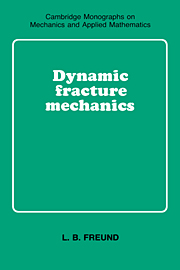Book contents
- Frontmatter
- Contents
- Preface
- List of symbols
- 1 Background and overview
- 2 Basic elastodynamic solutions for a stationary crack
- 3 Further results for a stationary crack
- 4 Asymptotic fields near a moving crack tip
- 5 Energy concepts in dynamic fracture
- 6 Elastic crack growth at constant speed
- 7 Elastic crack growth at nonuniform speed
- 8 Plasticity and rate effects during crack growth
- Bibliography
- Index
2 - Basic elastodynamic solutions for a stationary crack
Published online by Cambridge University Press: 03 October 2009
- Frontmatter
- Contents
- Preface
- List of symbols
- 1 Background and overview
- 2 Basic elastodynamic solutions for a stationary crack
- 3 Further results for a stationary crack
- 4 Asymptotic fields near a moving crack tip
- 5 Energy concepts in dynamic fracture
- 6 Elastic crack growth at constant speed
- 7 Elastic crack growth at nonuniform speed
- 8 Plasticity and rate effects during crack growth
- Bibliography
- Index
Summary
Introduction
Consider a body of nominally elastic material that contains a crack. For the time being, the idealized crack is assumed to have no thickness, that is, in the absence of applied loads the two faces of the crack coincide with the same surface in space. The edge of the crack is a smooth simple space curve, either a closed curve for an internal crack or an open curve intersecting the boundary of the body at two points for an edge or surface crack.
Under the action of applied loads on the boundary of the body or on the crack faces, the crack edge is a potential site for stress concentration. If the rate at which loads are applied is sufficiently small, in some sense, then the internal stress field is essentially an equilibrium field. The body of knowledge that has been developed for describing the relationships between crack tip fields and the loads applied to a solid of specified configuration is Linear Elastic Fracture Mechanics (LEFM). This a well-developed branch of engineering science which forms the basis for results to be discussed in this chapter and the next.
If loads are rapidly applied to a cracked solid, on the other hand, the internal stress field is not, in general, an equilibrium field and inertial effects must be taken into account. There is no unambiguous criterion for deciding whether or not loads are “rapidly” applied in a particular situation.
Information
- Type
- Chapter
- Information
- Dynamic Fracture Mechanics , pp. 55 - 103Publisher: Cambridge University PressPrint publication year: 1990
Accessibility standard: Unknown
Why this information is here
This section outlines the accessibility features of this content - including support for screen readers, full keyboard navigation and high-contrast display options. This may not be relevant for you.Accessibility Information
- 2
- Cited by
